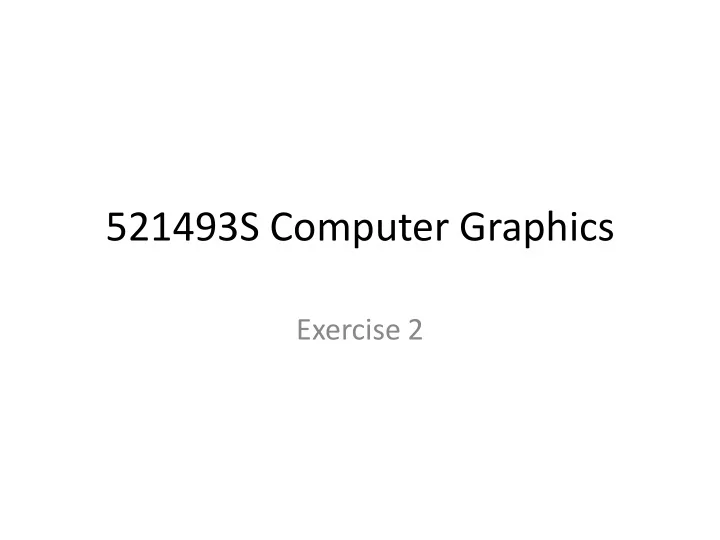

521493S Computer Graphics Exercise 2
Question 2.1 Given two nonparallel, three-dimensional vectors and , how can we form an orthogonal coordinate system in which is one of the basis vectors? Create basis vectors using and .
Solution 2.1 (1/9) • We can create orthogonal coordinates easily by using cross product: – Vector is now orthogonal to both and . – However, and are not necessarily orthogonal. We need third vector that is orthogonal to both and . – Now , and form an orthogonal coordinate system.
Solution 2.1 (2/9) • Calculating cross product using two 3D vectors
Solution 2.1 (3/9) • Calculating cross product using two 3D vectors
Solution 2.1 (4/9) • Calculating cross product using two 3D vectors
Solution 2.1 (5/9) • Calculating cross product using two 3D vectors
Solution 2.1 (6/9) • Calculating cross product using two 3D vectors
Solution 2.1 (7/9) • Calculating cross product using two 3D vectors
Solution 2.1 (8/9) • With and
Solution 2.1 (9/9) • We can also check the results by verifying that dot product between each result pair is zero:
Question 2.2 We can specify an affine transformation by considering the location of a small number of points both before and after these points have been transformed. In three dimensions, how many points must we consider to specify the transformation uniquely? How does the required number of points change when we work in two dimensions?
Solution 2.2 (1/3) • There are 12 degrees of freedom in the three- dimensional affine transformation. • Suppose a point that we are transforming to point by the matrix using relationship .
Solution 2.2 (2/3) • We have 12 unknown coefficients in and we get 3 equations for each pair of and • We need at least 12 / 3 = 4 pairs of matching points to solve the 12 unknown variables.
Solution 2.2 (3/3) • In two dimensions, there are 6 unknown variables • In two dimensions we get only two equations per point (x and y coordinates) • Therefore we need 6 / 2 = 3 matching points.
Question 2.3 Start with a cube centered at the origin and aligned with the coordinate axes. Find a rotation matrix that will rotate the cube first 45° around y-axis and then 45° around z-axis.
Solution 2.3 (1/3) • Transformation order is from right to left. So rotation around y-axis is on the right side of the rotation matrix.
Solution 2.3 (2/3) • Rotation matrices for y and z axes
Solution 2.3 (3/3) • We are using 45° angles to rotate. That makes calculations a bit easier
Question 2.4 Not all projections are planar geometric projections. Give an example of a projection in which the projection surface is not a plane, and another in which the projections are not lines.
Solution 2.4 (1/2) Eclipses (both solar and lunar) are good examples of the projection of an object (the moon or the earth) onto a nonplanar surface. Moon eclipses, derived from Phases_of_the_Moon.png in Wikimedia Commons by Miljoshi (Creative Commons Attribution 2.5 Generic)
Solution 2.4 (2/2) All the maps in an atlas are examples of the use of curved projectors. If the projectors were not curved we could not project the entire surface of a spherical object onto a rectangle.
Question 2.5 If we were to use orthogonal projections to draw the coordinate axes, the x and y axes would be like in the plane of the paper, but the z axis would point out of the page. Instead, we can draw the x and y axes as meeting at a 90-degree angle, which the z axis going off at -135 degrees from the x axis. Find the matrix that projects the original orthogonal-coordinate axes to this view.
Solution 2.5 (1/3)
Solution 2.5 (2/3) • We need to project where and . • Z-axis is projected to the same plane with x and y axes with a -135 degree angle from positive x axis. α is the length of the vector.
Solution 2.5 (3/3) • As α was not given, we can choose to get a simple looking projection matrix
Solution 2.5 (3/3) • As α was not given, we can choose to get a simple looking projection matrix For 3-D -> 2-D projection, erase this row
Question 2.6 Find the projection of a point onto the plane from a light source located at infinity in the direction .
Solution 2.6 (1/6)
Solution 2.6 (2/6) • All the projected points of the point to the direction of are of form . Thus, shadow of the point is found by determining for which the line intersects the plane
Solution 2.6 (3/6) • After solving the equation, we find • However, what we want is a projection matrix. We can use the above value to solve and the same for other dimensions.
Solution 2.6 (4/6)
Solution 2.6 (5/6) • And we can do the same for y and z
Solution 2.6 (6/6) • These results can be computed by multiplying the homogenous coordinate point by the projection matrix
Recommend
More recommend